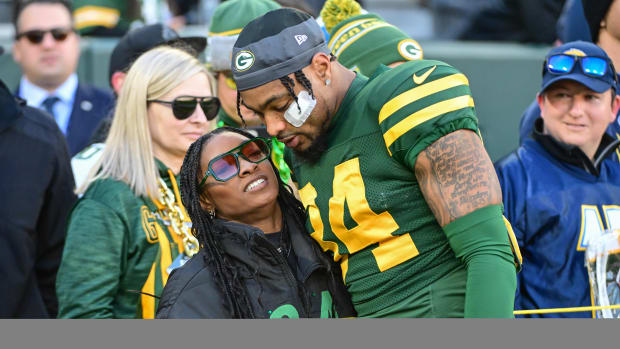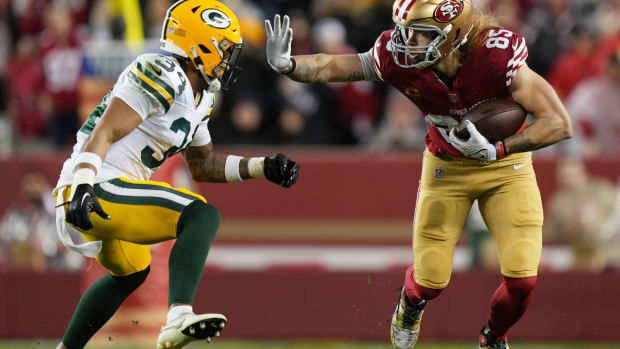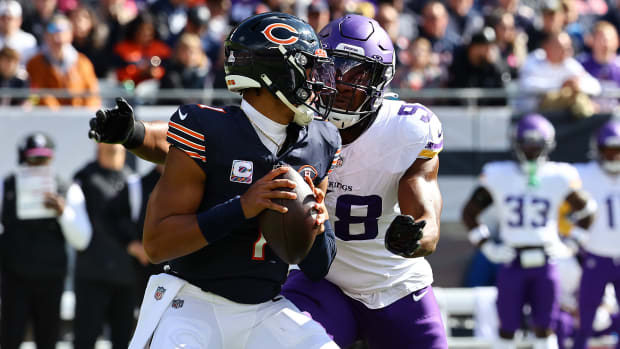Where Bears Signings Improve Capability
Apparently there's great improvement and then there's great improvement.
A few post-free agency and overall improvement assessment reports came out on various websites and although the Bears are judged to have succeeded greatly in free agency, they're still regarded among the league's lightweights in most cases.
It's why ESPN could give them a power ranking of 27th despite getting a free agency grade from CBS Sports of A and a B from Pro Football Focus.
"With free agency, we stuck to our plan," GM Ryan Poles said. "And that's really to marry a fit for what we're trying to do here-our culture, our scheme-with value."
The problem was, they had a lot of needs to fit.
The high grades for free agency married with the poor overall ranking just indicates the hole they started from in building this season.
They've still got a long way to go.
Here's an attempt to rank how what they have done in free agency in terms of how it has affected what they can do going forward.
1. Pass Defense
They were good at this early last year and only declined due to injuries and lack of pass rush. Taking PFF's highest-rated pass defender at linebacker in Tremaine Edmunds, putting him with T.J. Edwards coming off his best year as a pass defender, and then placing both in front of a secondary now healthy after 23 games missed between five starters in the season's second half—they were ranked 12th against the pass halfway through the year—should put this pass defense in order. What they did at linebacker greatly improved a strength. If only they had a pass rush to improve it some more.
2. Pass Receiving
This goes for receivers and tight ends. Take away points for losing David Montgomery, who was an excellent receiver. However, now they have a No. 1 receiver with DJ Moore and makes a world of difference when he's combined with two other experienced, productive pass catchers. They have a diversity of strengths—Darnell Mooney with speed and route running, Chase Claypool with his size/speed combination and DJ Moore as a yards-after-catch and all-around threat. Throw in Robert Tonyan to complement Cole Kmet a year after they had only 13 targets for tight ends besides their starter, and Fields might have a hard time choosing which receiver to throw to after he had a hard time finding one open in 2022. He won't be relying on Equanimeous St. Brown as his second receiver or Byron Pringle, N'Keal Harry and Dante Pettis for occasional catches.
3. Passing
If Justin Fields has better pass receivers because of free agency, and the running attack might even be better, then it stands to reason his own passing can be better. The receivers should be open more often and he'd have longer to throw. So a 60.4 completion percentage should go up. He now has Moore, who PFF says had the league's second-most targets from a range of 10-19 yards over the last four years. That's important because PFF says Fields had a 66.7% completion rate on throws of 10-19 yards last year, which was No. 1 in the NFL for that range. They have given him the best possible available weapon to suit his strength.
4. Run Defense
The 31st-ranked run defense in the league last year had a long way to go and still can get better. However, three-technique Justin Jones can now work beside a bigger and more active one-technique in Andrew Billings, and they have Edwards behind them after he rated as 16th best run defender at linebacker according to PFF. DeMarcus Walker was an above-average run defender as a more stout defensive end and also lined up over tackle or outside it about two-thirds of the time last year. They already were getting decent play against the run on one end from Trevis Gipson, who ESPN graded as eighth overall in terms of run-defense win rate among ends. They could really use another inside player but any edge player they need is one who must be able to pass rush and not necessarily shut off the run. Another defensive tackle is required to pad depth if not add explosive potential.
5. Running
It's not a reflection on David Montgomery's effort or running ability but D'Onta Foreman's ability to be a one-cut back makes him more ideal for the running system. So overall they have improved the run game. NextGen Stats determined Foreman and Khalil Herbert rated top six among the more efficient runners with the ball in the league, far better at this than Montgomery because he dances more. The new Bears backfield moves straight upfield after a cut more than Montgomery does in terms of time and yards actually spent carrying the football. This blocking scheme apparently doesn't work as well with dancing Bears, even if they can run over defenders.
6. Run Blocking
Nate Davis for Teven Jenkins doesn't look like an improvement at right guard in terms of run blocking, if you rely on PFF grades. But what needs to be remembered is Davis has been more consistent as a run blocker. Jenkins, himself, says consistency is his problem. Jenkins was a devastating run blocker at times last year, and if he's being moved to left guard then they could have two excellent run -blocking guards. There's no telling what they would get by moving Davis to left guard because he's never played there just as Jenkins hasn't played left guard. However, his consistency is established at right guard so it's probably best to leave him there.
Overall, this looks like a minor boost but the bigger boost is moving guard Cody Whitehair back to center and it had nothing to do with free agency. Whitehair had PFF run-blocking grades at the superior level as a rookie and into his third year, when they let him remain at center. When he moved to guard full-time in 2020, he had his only superior run-blocking grade at that position and has been only so-so since.
Meanwhile, Sam Mustipher struggled to be an average center blocking the run and did get better at it last year, just not good enough to be given a restricted free agent tender. The tell-tale sign for whether the line improves at blocking the run over last year when they led the league in rushing will be if they can block short yardage better, near the goal line or on third- and fourth-and-short. That's always a true test, unless you're the Eagles and just have your quarterback legally burrow for 2 or 3 yards.
Another overlooked area in run blocking is support from the wide receivers and tight ends. Tonyan has been so-so as a run blocker and they brought Moore here to be a playmaker, not a blocker.
7. Pass Blocking
Whether they've actually gotten better blocking for the pass with Jenkins at left guard and Davis staying at right guard is the issue and it remains to be seen as their pass-blocking grades have been about the same.When Whitehair was at center for three years, he allowed four sacks, 51 pressures and three QB hits. There was a stretch of about 200 plays in his second season when he got moved both to left and right guard because of injuries but played three-quarters of the year at center. For roughly the same number of games in his three years, Mustipher allowed four sacks, 58 pressures and eight hits. But this switch did not really result from free agency.
8. Pass Rushing
Particularly off the edge, they were so bad at this last year that they might be able to spend two more free agency periods and not reach an acceptable level. They've done very little to help this. It's a reason why that decision between pass rusher and offensive tackle is so tough to make in Round 1 of the draft.
The free agency period only helped in terms of bringing in Walker, whose seven sacks and 16 QB hits last year were far and away highs in a journeyman's career and not necessarily common for his first four seasons. He had some of that pressure coming from a three-technique spot, anyway. While this helps the overall rush, it doesn't boost their anemic outside pass rush. They do have more money to spend in free agency and there are veteran rent-a-sacker types available for a season. They can usually be found until the start of minicamps in June. Even if the Bears come up with edge rush help in the draft, it's uncertain how much a rookie could help off the edge. Only three rookie edge rushers had more than four sacks. It's a position that can require a year or so to work into for rookies. So they better get after it in extended free agency sometime.
Twitter: BearDigest@BearsOnMaven





